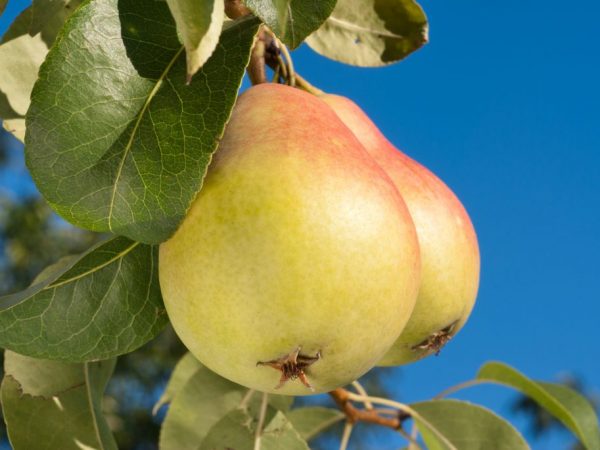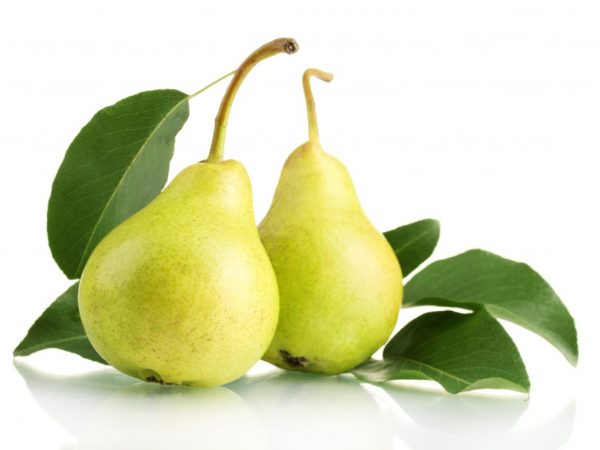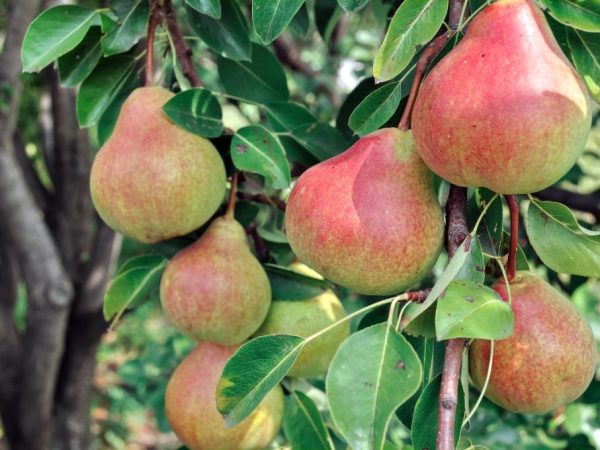Characteristics of self-fertile varietal pears
Self-fertile varieties of pears are self-pollinated pears, they can grow apart, bear fruit successfully and give a decent harvest. In the article, we will consider what self-pollinated varieties exist and how they differ from each other.

Characteristics of self-fertile varietal pears
Popular varieties
When choosing a pear for your garden, it is important to understand what qualities you need to pay attention to, and this is not only self-fertility, but also frost resistance, ripening time, yield, characteristics of fruits, taste.
Long-term work of breeders has made it possible to develop such self-fertile varieties that have a set of advantages, which will satisfy the requirements of many gardeners.
Lada
An early-ripening summer variety bred on the basis of K.A. Timiryazev's academy. Ideal for cultivation in the middle lane. Differs in high frost resistance. Begins to bear fruit in 3 years from the moment the seedling is planted. Yielding, after 6-7 years from the moment of planting, it gives 35-45 kg of fruit, which ripen in mid-July.
Fruit
The fruits are not large, 110-130 g with a pale yellow thin skin, with a slight blush. The structure of the pulp is dense, has a sweet-sour taste. The fruits are suitable for storage for two months at a temperature of 2-5 ° C.
Features of the
Among the disadvantages are:
- poor transportability;
- shedding of fruits;
- poor tolerance to prolonged drought.
Lada is self-fertile, but if grown in the vicinity of other pear trees, the yield increases by 10-15%. And also the quality of the fruit improves depending on which pears grow nearby. For such purposes, they practice in the garden to plant or graft Rogned, Skorospelka, Chizhevskaya, Memory Zhegalov on the main tree.
Prominent
Bred as a result of pollination of hybrid VI-53-67 with a mixture of southern pear species. Has absorbed the best qualities. Designed for cultivation in the Central region. It belongs to the mid-season, ripens from mid-August to the end of September. Ripening is gradual, extended for 1-1.5 months. It has a high yield, more than 50-60 kg of fruits are harvested from one adult tree.
Fruit
Fruits grow in weight from 150 to 220 g, symmetrical, elongated, from green to yellow, with a slight blush on the side, the skin is dense with a distinct tuberosity, sweet in taste. The pulp has a homogeneous structure, no graininess can be traced. Suitable for fresh consumption, cooking and processing into confitures, jams. A distinctive feature is a very small seed nest, with 4-5 seeds.
Features of the
Popular in industrial cultivation to provide a fresh fruit market. It has good transportability and a beautiful presentation, but it can be stored for a short period (up to 2 weeks).
Chizhevskaya

The variety will delight you with its yield
One of the best self-fertile varieties of pears during the summer ripening period. Differs in high and regular productivity, early maturity. Not picky about care, resistant to low winter temperatures.It blooms in mid-May, which reduces the chances of freezing of the color and ovary. Suitable for growing in the middle lane with a temperate climate.
Fruit
The first fruits are tied 3-4 years after planting a seedling or grafting. Differs in regular high productivity. One tree can ripen 55-60 kg of pears. Ripeness is reached in August. The fruits are even pear-shaped, reaching an average weight of 130-155 g. The skin is smooth, no tuberosity is noted, green, at the time of full ripening with a yellow tint. They have a distinct taste, sweet, with a high sugar content of 9.5%. The pulp is homogeneous, pale yellow in color, the structure of the fruit is oily, moderately juicy.
Features of the
Among the advantages are:
- good portability;
- storage possibility up to 4 months;
- fruits do not crumble;
- drought and frost resistance.
The disadvantages of the Chizhevskaya pear include the tendency to reduce the size of the fruit after reaching the age of 25-30.
Dessert varieties
Dessert self-fertile varieties have gained their popularity among gardeners due to the high rates of sweetness and juiciness of fruits in such fruit trees. But among all dessert varieties, the best are named:
- Veles;
- Otradnenskaya.
Veles
Autumn variety, bred as a result of crossing the Forest Beauty and Venus. In a short time, it gained popularity among many gardeners due to its beautiful shape and high taste characteristics. Velesa (Daughter Excellent) easily tolerates winter frosts down to -25 ° C, but tends to freeze at a young age during the spring frost. Suitable for growing in areas of moderate continental climate.
Fruit
The fruits have an average weight of 180 g, but in the first years, larger specimens weighing more than 200 g are observed, they are distinguished by a rounded shape with an even and smooth surface, ripen in September. The skin color is green with a distinct orange-red blush. The pulp is dense, juicy, homogeneous, pleasant to the taste.
Features of the
The trees are medium-sized with well-developed skeletal branches, the crown is pyramidal. Begins to bear fruit at 5-6 years. Veles can be stored well for 4-5 months. For industrial purposes, they are used for the preparation of jams and juices, sometimes as raw materials for candied fruits.
Otradnenskaya

The fruits are good for processing
The variety of the autumn ripening period was bred as a result of crossing the Tema and the Forest Beauty. Easily tolerates low temperatures. It is rarely affected by diseases and various pests.
Fruit
Fruits are not large, 100-130g round. The skin has a green base color, but gradually turns yellow with an indistinct red blush. Small subcutaneous points are traced, poorly expressed. The pulp has a sweet and sour taste, the aroma is weak, fine-grained.
Features of the
Otradnenskie pears are undersized, standard. Begin to bear fruit for 3 years. Productivity is regular and stable, 30-40 kg / tree. Shelf life after harvesting 100-120 days (at 0-3 ° C). The fruits have a good presentation, are suitable for long-term transportation, and are resistant to mechanical damage. One of the best self-fertile varieties for industrial cultivation and processing.
Columnar varieties
Columnar fruit trees have become very popular among gardeners in recent years.
Due to their compactness, they are ideal for household plots with a minimum area, they are especially decorative during the flowering and fruiting period. Among this type of pear, there are also self-fertile varieties that are worth paying attention to.
Decor
This is a columnar self-fertile pear that grows up to 2 m in height, and begins to bear fruit already in the second year after planting the seedling. Belongs to early autumn, the fruits begin to ripen at the end of August. The yield is stable, 8-10 kg of fruit can be harvested.
Fruit
The decor is a large-fruited variety, pears have an average weight of 230-250g. The skin is smooth, beautiful golden color, there is no blush.The pulp is juicy, homogeneous, white. The fruits are sweet with a delicate dessert taste. Often used in cooking.
Features of the
The following advantages are noted:
- early maturity, bears fruit for 2 years;
- frost resistance, at -30 ° С no frosting is observed;
- resistance to moniliosis and clasterosporiosis;
- compactness, 3 square meters is enough for one tree. m. area;
- does not require pruning.
The disadvantage is the fragility and the need to update every 15-20 years.
Sapphire F1
This is an autumn large-fruited hybrid. The pears of which begin to ripen in the middle of September. The yield is stable within 6-8 kg.
Fruit
Fruits are beautiful pear-shaped, weighing 200-230g. The skin is dense, greenish-yellow with a slight orange blush. The pulp is firm, moderately juicy, granularity is not felt. Sapphire pears are sweet, have a strong aroma, for table use, and are suitable for confectionery.
Features of the
Stores well for 2-3 months at a temperature of 0-5 ° C. Differs in undemanding care, winter hardiness. Suitable for cultivation in areas of the middle lane.
Conclusion
If you want to grow a pear, but there is no room in the garden for planting pollinators, then self-fertile varieties are an excellent option. They will be able to please with a high-quality harvest and delicious fruits.


